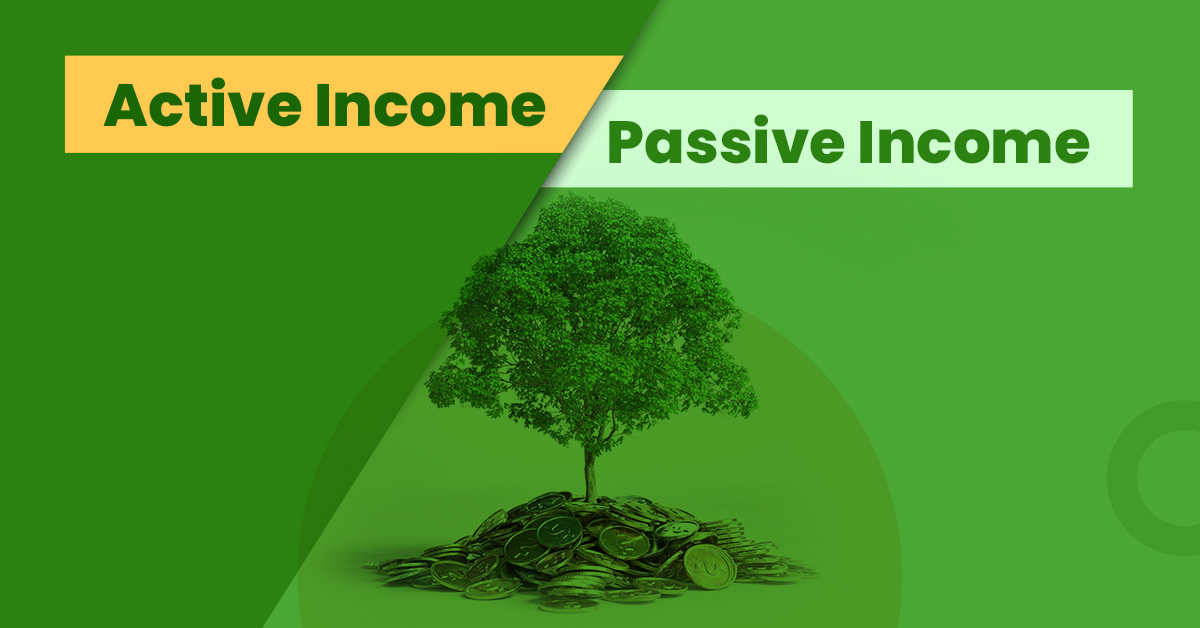The world of finance is a complex and multifaceted landscape, with numerous avenues for generating income. Among the various forms of revenue, active and passive income stand out as two distinct paradigms. Understanding the difference between active and passive revenue is essential for anyone seeking to optimize their financial strategies, whether for personal financial planning or business ventures. In this comprehensive article, we will delve deep into the realm of active and passive revenue, exploring their definitions, characteristics, advantages, disadvantages, and practical applications.

Difference between Active and Passive Revenue?
I. Defining Active and Passive Revenue
Before delving into the differences between active and passive revenue, it is crucial to establish a clear understanding of each concept.
A. Active Revenue
Active revenue, often referred to as earned income, is income that is generated through active participation or effort. This form of income is typically associated with traditional employment, self-employment, or entrepreneurial endeavors where individuals actively exchange their time, skills, or expertise for financial compensation.
1.Characteristics of Active Revenue
a. Active Participation: Active revenue requires continuous personal involvement and effort. It often involves trading hours for dollars, where the more you work, the more you earn. b. Labor-Intensive: Activities that generate active revenue can be physically and mentally demanding. This may involve working a 9-to-5 job, running a business, or freelancing. c. Instant Gratification: Income generated from active efforts is typically received immediately or at regular intervals, such as a monthly paycheck. d. Taxation: Active revenue is usually subject to income tax at various rates, depending on your location and income level. e. Limited Scalability: Active income is often limited by the number of hours a person can work, making it challenging to scale up without sacrificing work-life balance.B. Passive Revenue
Passive revenue, also known as unearned income, represents income generated with minimal direct involvement or ongoing effort. Passive income streams typically require an initial investment of time, money, or resources but can yield returns with reduced or no active participation over time.
1.Characteristics of Passive Revenue
a. Limited Involvement: Passive revenue does not necessitate constant or extensive effort once the initial setup is complete. It often allows you to generate income without day-to-day management. b. Investment Requirement: Passive income often demands an initial investment, whether in the form of capital, intellectual property, real estate, or other assets. c. Deferred Gratification: Passive revenue may not provide instant rewards. Instead, it often involves a waiting period for the income stream to gain momentum and grow. d. Taxation: Passive income is typically subject to different tax rates or benefits, depending on the source and jurisdiction. e. Scalability: Passive income sources can be scaled more easily, allowing for the potential to generate larger sums of money without the same level of continuous effort as active income.II. Key Differences between Active and Passive Revenue
Now that we have established the definitions of active and passive revenue, it is time to explore the fundamental distinctions between these two income paradigms.
A. Source of Income
Active Revenue: The primary source of active revenue is direct personal effort, expertise, and labor. This can include traditional employment, freelancing, running a business, or providing services.
Passive Revenue: Passive income typically originates from investments, assets, or business ventures that require initial setup and capital. Common sources of passive income include rental properties, dividends from stocks, royalties from intellectual property, and interest from savings accounts.
B. Level of Involvement
Active Revenue: Active income demands constant or regular involvement. You need to invest your time, energy, and skills consistently to generate active income. When you stop working, your active income stops as well.
Passive Revenue: Passive income requires minimal day-to-day involvement once the initial work or investment is completed. While periodic maintenance may be necessary, passive income streams can continue to generate revenue without continuous personal effort.
C. Time Horizon
Active Revenue: Active income provides immediate or short-term financial gratification. You receive compensation for your work shortly after completing it, such as a monthly salary or payment for services rendered.
Passive Revenue: Passive income typically has a longer time horizon. It may take time for passive income streams to build and become substantial. However, once established, they can continue to provide income with less active engagement.
D. Taxation
Active Revenue: The taxation of active income varies based on your income level, deductions, and local tax laws. In many cases, active income is subject to progressive income tax rates, with higher earners paying a greater percentage of their income in taxes.
Passive Revenue: The tax treatment of passive income varies depending on its source and local tax laws. Some passive income, such as capital gains and qualified dividends, may receive preferential tax rates. Additionally, some passive income sources can be structured to minimize tax liability.
E. Scalability
Active Revenue: Scaling active income can be challenging, as it often depends on the number of hours you can work or the market demand for your skills or services. Expanding active income may require more personal effort and time.
Passive Revenue: Passive income sources are often more scalable. You can invest in additional assets or allocate more resources to expand your passive income streams without the same level of continuous effort as active income.
III. Advantages and Disadvantages of Active and Passive Revenue
Both active and passive revenue streams offer unique advantages and disadvantages. Understanding these can help individuals make informed decisions about their financial strategies.
A. Advantages of Active Revenue
- Predictable Income: Active income offers a stable and predictable source of income, making it easier to budget and plan for expenses.
- Skill Development: Active income often involves the development of marketable skills, professional growth, and networking opportunities.
- Immediate Rewards: You receive compensation for your efforts promptly, providing financial stability and meeting short-term financial goals.
- Hands-On Control: Active income allows you to have direct control over your earnings and career decisions.
- Steady Employment: Many individuals prefer the security of a steady job or business that generates active income.
B. Disadvantages of Active Revenue
- Limited Time: Active income relies on the time you invest, which can lead to overwork, burnout, and difficulty achieving work-life balance.
- Income Ceilings: There is often a cap on how much you can earn from active income due to the finite number of hours in a day and the market demand for your skills.
- Vulnerability to Economic Downturns: Active income sources may be sensitive to economic fluctuations, job market changes, or industry-specific crises.
- Reduced Flexibility: The demands of active income sources can limit your ability to pursue other interests or ventures.
- Retirement Challenges: Relying solely on active income can pose challenges in retirement planning, as your income may decrease or cease upon retirement.
C. Advantages of Passive Revenue
- Reduced Involvement: Passive income allows for more leisure time and flexibility, as it does not require constant active engagement.
- Potential for Financial Independence: Passive income can provide a path to financial independence and early retirement by generating income without continuous effort.
- Diversification: Passive income sources offer an opportunity to diversify your income streams, reducing risk and enhancing financial stability.
- Scalability: Passive income streams can be scaled more easily, allowing for substantial growth in your overall income.
- Tax Benefits: Some passive income sources benefit from favorable tax treatment, potentially lowering your overall tax liability.
D. Disadvantages of Passive Revenue
- Initial Investment Required: Many passive income sources demand a significant upfront investment, which may be a barrier for some individuals.
- Delayed Returns: Passive income often requires patience, as it can take time to see substantial returns on investments or business ventures.
- Risk and Volatility: Not all passive income sources are risk-free, and some may be subject to market fluctuations or unforeseen challenges.
- Lack of Control: In certain passive income investments, you may have limited control over how the income is generated or managed.
- Ongoing Maintenance: While passive income requires less active involvement, some level of maintenance or oversight is often necessary.
IV. Practical Applications of Active and Passive Revenue
The choice between active and passive revenue depends on an individual's financial goals, risk tolerance, and lifestyle preferences. Understanding the practical applications of both income paradigms can help you make informed decisions.
A. Practical Applications of Active Revenue
- Employment: Active revenue is the primary source of income for many individuals through traditional employment. It provides a steady paycheck, benefits, and job security.
- Entrepreneurship: Starting and running a business is a common way to generate active income. While it requires significant effort, it offers the potential for higher earnings and autonomy.
- Freelancing and Consulting: Freelancers and consultants can earn active income by offering specialized services to clients or companies.
- Commission-Based Work: Sales professionals, real estate agents, and insurance agents often earn commissions based on their sales performance, representing active income.
- Gig Economy: Active income can be generated through gig economy platforms, such as ridesharing or food delivery services.
B. Practical Applications of Passive Revenue
- Investments: Investing in stocks, bonds, real estate, and other assets can generate passive income through dividends, interest, and rental income.
- Real Estate: Owning rental properties is a common way to earn passive income, as tenants provide a steady stream of rent payments.
- Intellectual Property: Authors, musicians, and creators can earn passive income from royalties on books, music, and other intellectual property.
- Dividend Stocks: Investing in dividend-paying stocks can provide a consistent stream of passive income.
- Retirement Accounts: Contributions to retirement accounts, such as 401(k) and IRAs, can grow over time and provide passive income during retirement.
V. Strategies for Combining Active and Passive Revenue
While active and passive revenue streams are often considered separately, they can be effectively combined to create a diversified and sustainable income portfolio.
A. Creating a Balanced Income Portfolio
- Start with a Financial Plan: Develop a comprehensive financial plan that outlines your financial goals, risk tolerance, and investment horizon.
- Prioritize Saving and Investing: Allocate a portion of your active income towards savings and investments to build passive income streams.
- Diversify Investments: Diversify your passive income sources, which may include stocks, bonds, real estate, and other assets, to spread risk.
- Explore Entrepreneurship: If you have entrepreneurial ambitions, consider starting a business that can eventually generate passive income.
- Invest in Education: Continuously improve your skills and knowledge to increase your earning potential in active income sources.
B. Transitioning from Active to Passive Income
- Save and Invest Early: Start investing and saving as early as possible to benefit from compounding and long-term growth.
- Reduce Debt: Minimize high-interest debts to free up more funds for investment and savings.
- Real Estate Investment: Consider real estate investments that provide rental income, which can serve as a bridge from active to passive income.
- Create Intellectual Property: Develop content, products, or services that can generate passive income through royalties or sales.
- Seek Financial Advice: Consult with financial professionals or advisors to create a customized plan for transitioning to passive income.
C. Passive Income to Enhance Active Income
- Emergency Fund: Build a financial cushion through passive income sources, allowing you to have more security and flexibility in your active income endeavors.
- Investment Gains: Use passive income from investments to supplement your active income, providing additional financial stability.
- Retirement Planning: Accumulate passive income sources that can support your retirement lifestyle, reducing the pressure on active income in your golden years.
- Skill Development: Invest in skill development and education using passive income, enhancing your earning potential in active income sources.
- Risk Mitigation: Passive income can act as a safety net in case of unexpected job loss or other financial setbacks, providing peace of mind.
VI. Conclusion
Active and passive revenue represent two distinct approaches to income generation, each with its own set of advantages and disadvantages. While active income relies on personal effort and immediate rewards, passive income offers the potential for financial independence and long-term financial stability. Choosing between these income paradigms should align with your financial goals, risk tolerance, and lifestyle preferences.
Moreover, it is important to recognize that the most successful financial strategies often involve a combination of active and passive income streams. By creating a balanced income portfolio and leveraging the strengths of both paradigms, individuals can optimize their financial well-being, work towards financial independence, and secure a prosperous future. Ultimately, the path to financial success depends on your unique circumstances and the careful consideration of the active and passive revenue options available to you.
Read More:- How to Define Transparency in Business: The Hidden Key to Corporate Profits Read More:- Top 10 Diwali Marketing Ideas for Fashion Business
